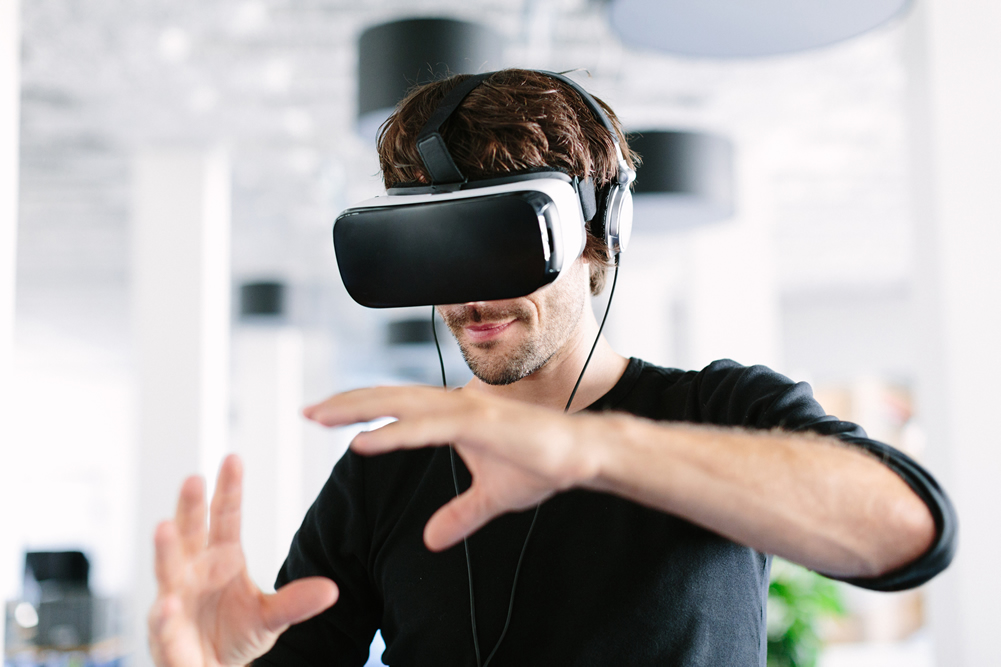You may not immediately think of virtual reality (VR) as something to assist Human Resources (HR) professionals. VR first came into the mainstream primarily as an entertainment technology that brings people into immersive worlds for gameplay and fun. As you’ll soon see, it has impressive potential in the HR sector.

Provide Training in More Effective Ways
Many current and past members of the workforce recall hours of reading chapters in manuals for training or watching outdated videos. The content improved a bit when HR professionals started using computers more often. Even that situation meant that people often had to complete training by themselves, usually sitting in a room and clicking through modules.
Companies are now using VR more often to help employees learn what they should know. Walmart uses virtual reality in 4,700 of its locations to give training without instructor intervention. Verizon depends on it to teach workers what to do during armed robberies.
The technology is also becoming more popular in the construction industry, particularly for safety modules about working at heights. VR enables safe simulations of scenarios that are otherwise difficult to recreate.
Make Recruitment Easier and More Engaging
Many companies find their new candidates by going beyond the basic procedures of reading a person’s cover letter and résumé. As an applicant passes through the hiring process, the business may ask the person to go through exercises that illuminate some of the personality traits or show how he or she would respond if encountering a particular scenario while on the clock.
Accenture depends on VR to help fill its consultancy and tech roles and typically gives people multiple modules to do. The scenarios let people show off their skills and how they’d deal with situations in ways that might not become apparent through conventional recruitment measures.
It’s also easy to see how VR could help companies attract attention in crowded areas. Research shows that 80% of Generation Z is more likely to visit stores that offer technology or augmented reality. Retailers know that high-tech offerings appeal to people. Using them to generate interest could work exceptionally well for a tech-centric company or one that wants to seem on the cutting edge.
Offer Smoother Onboarding Processes
The first week or so of working at a new job often includes a mixture of boring and somewhat exciting responsibilities. People frequently fill out paperwork for tax and payroll purposes, but they’re also likely to have lunches with their team members.
HR professionals are increasingly interested in using VR for the onboarding process. Imagine if a system provided a gamification aspect that gave people points for every document they filled out or each item checked off a first-week to-do list. That approach could keep people motivated during their early days at a company and give them great first impressions.
VR could also help new hires become more familiar with their colleagues. Maybe a CEO spends most of his or her time on another continent, making it impossible for a new C-suite team member to meet him or her right away. Perhaps a sizable percentage of your team works remotely, making in-person meetings more challenging. VR can assist in those situations by cultivating personal connections across the miles.
Support Safer and Distanced Interactions
You could also argue that VR is available at an ideal time. The global COVID-19 pandemic forced people to learn new ways to interact without risking becoming infected or transmitting the virus. HR professionals might use VR headsets to distribute companywide material without requiring everyone to be in the same room at once or congregating in large groups.
Many VR companies specifically angle their products toward the business sector. Some offerings even allow people to use VR for meetings, complete with technology that lets each attendee have an avatar. These options support the new normal created by the coronavirus. They help people engage with each other without ignoring social distancing interactions.
HR professionals are like most people in that they’re still trying to iron out what it means to live in a world where exposure to a deadly virus is an ever-present risk. VR modules could remove the challenges of having people engage with one another while keeping far enough apart. There is also an app that blends the Zoom videoconferencing platform with VR. It allows people to join even if they don’t have VR headsets.
Increase Employee Retention with Realistic Modules
Given the time required to find new employees and get them up to speed with the necessities of their work, HR professionals prefer to keep the people they have rather than frequently hire new team members. VR modules could make that goal easier to achieve by setting more accurate expectations about the work and the company.
FedEx had problems with new hires quitting soon after joining. The workers felt overwhelmed by the physical nature of the work and the volume of parcels handled. The company dealt with the obstacle by using VR to aid retention. People could go through modules that showed them authentic work environments. Then, when those team members had their first few days or weeks on the job, the duties would not take them by surprise.
A person could even go through a virtual tour of the workplace before filling out an application. Doing that would help him or her get an idea of the company culture and layout so he or she could better envision working there.
Fascinating Possibilities with VR
VR can help people have fun, but the viable use cases for the technology span far beyond that. HR professionals will still play prominent roles in people’s workplace experiences, but VR will add a new, versatile level of interaction.
Kayla Matthews, a technology journalist and human resources writer, has written for TalentCulture, The Muse, HR Technologist, Inc.com, and more. For more by Matthews, follow @KaylaEMatthews on Twitter or visit her blog, Productivity Bytes.
